The Rebirth of Industrial Spaces through the Prism of Culture and Creativity
The EU financial boost for revitalisation strategies and plans
Two of the most visible projects funded by the EU's Interreg programmes for Central Europe, were Second Chance "From Industrial Use to Creative Impulse" (Interreg 2007–2013) and REFREsh "Rural rEvitalisation For cultuRal hEritage" (Interreg 2014–2020). Both address the regeneration of post-industrial sites.
The Second Chance project (2010–2013) aimed at revitalising degraded, brownfield sites of historical value in Nuremberg, Venice, Krakow, Ljubljana and Leipzig. It sought to transform such locations into cultural sites and, along the way, find, invent and share innovative revitalisation strategies, to shape them into long-term management plans, along with relevant policies. The concept was based on public-private partnership models to guarantee the sustainability of the new cultural centres, while the development vision was presented "in a small scale", as pilots.
 The exterior of RogLab a unique inter-organisational collaboration set in a container, 2021. Photo: Kaja Brezočnik.
The exterior of RogLab a unique inter-organisational collaboration set in a container, 2021. Photo: Kaja Brezočnik.
The result in Ljubljana was a small production space known as RogLab, placed in a container – a modern piece of architecture, conceived by Jure Kotnik Architecture –, testing content and enhancing partnerships for the development of the former bicycle factory Tovarna Rog into a creative hub.
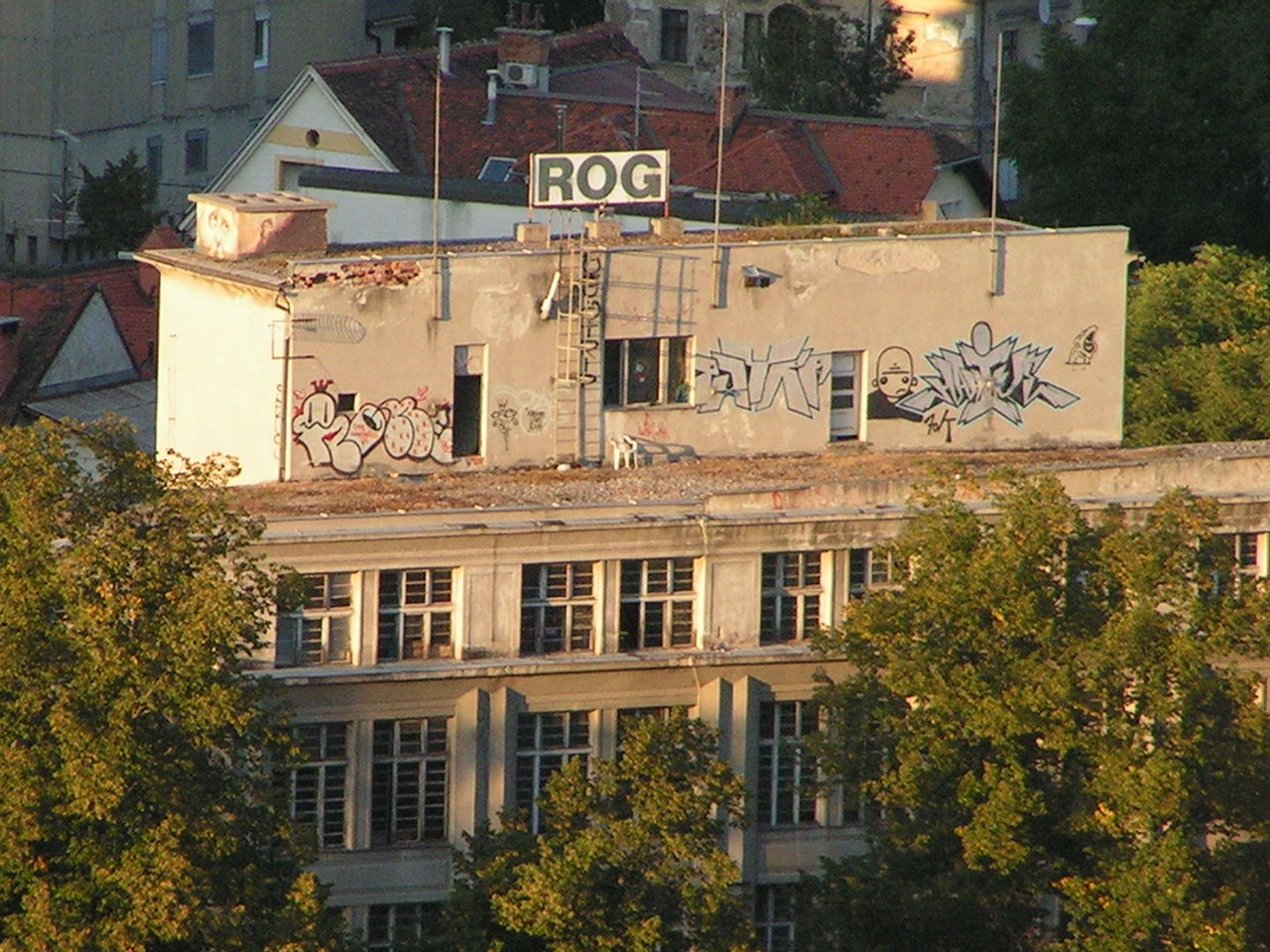
REFREsh addressed the development and (re)utilisation of industrial heritage in rural areas in the Central European region, finding sustainable solutions and presenting new forms for their creative use. Partners from Germany, Hungary, Slovenia, Italy and Croatia collaborated for three years (2017–2020) to transform five selected industrial sites into cultural centres.
Built in the second half of the 19th century on the Slovenian coast, the Monfort warehouse, together with the Grando warehouse, presents a rare example of a preserved salt warehouse of the formerly-important salt industry. The concept for the Monfort Salt Warehouse was developed by the Institute for the Protection of Cultural Heritage of Slovenia and the Municipality of Piran-Pirano, along with guidelines for future revitalisation of the whole area, including the nearby Grando Warehouse.
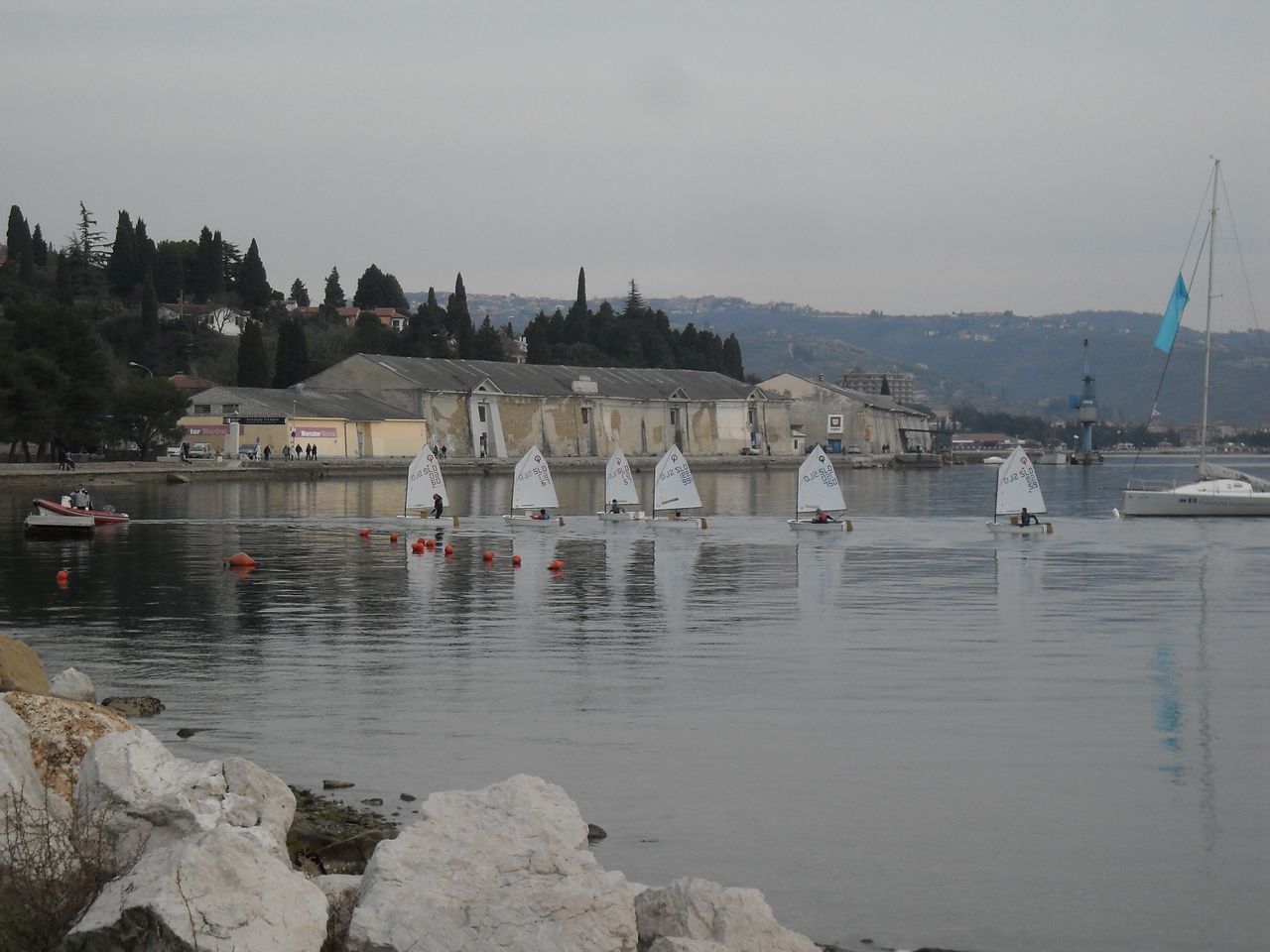 Monfort Salt Warehouses Portorož, an exhibition space for the Collection of Traditional Shipbuilding and the Development of Water Sports of the Sergej Mašera Maritime Museum, Piran and Obalne galerije - Coastal Galleries exhibitions and festivals.
Monfort Salt Warehouses Portorož, an exhibition space for the Collection of Traditional Shipbuilding and the Development of Water Sports of the Sergej Mašera Maritime Museum, Piran and Obalne galerije - Coastal Galleries exhibitions and festivals.
Monfort has five campat areas, or sections. In the frame of REFREsh, three campats were refurbished and maintenance work was carried out on one of the sections, enabling its use for various cultural events. Even before this renovation, it functioned as the Monfort Exhibition Space, hosting the Piran Days of Architecture and the Festival of Slovenian Film, among other events and exhibitions.
 An Piran Days of Architecture exhibition conducted at the former salt storehouse Monfort , now an exhibition and event space.
An Piran Days of Architecture exhibition conducted at the former salt storehouse Monfort , now an exhibition and event space.
Yet another project addressed the re-use of abandoned spaces and places. Funded by the EU programme Europe for Citizens, the project NIFOB "New Ideas for Old Buildings" (2015–2016) connected 7 small-to-medium-sized towns in 6 countries: Latvia, Germany, Slovenia, Croatia, Serbia, Montenegro, to explore how the towns use empty spaces and to find solutions for revitalising towns with action plans for the repurposing of old buildings. The NIFOB project outputs presented guidelines on how to effectively manage (empty) public property and an action plan for how to complement municipal services with self-organised initiatives.
The Municipality of Ajdovščina was the lead partner, with IPoP - Institute for Spatial Policies and the Municipality of Maribor among the local partners. Wanting to explore the potential of empty industrial buildings in the heart of the Maribor city centre, the latter shared the example of Tkalka (Weaver). Previously the headquarters of a galenical laboratory, at the time of the project, it had become a vibrant community space to support creative and social enterprises, cooperatives and associations. Due to the planned sale of the building, most of the groups left the space in 2019, yet the Municipality of Maribor issued a public call for rent again in 2020.
Visions for the capital city
In the last two decades, the Municipality of Ljubljana has been persistent in renovating and opening (new) cultural venues.
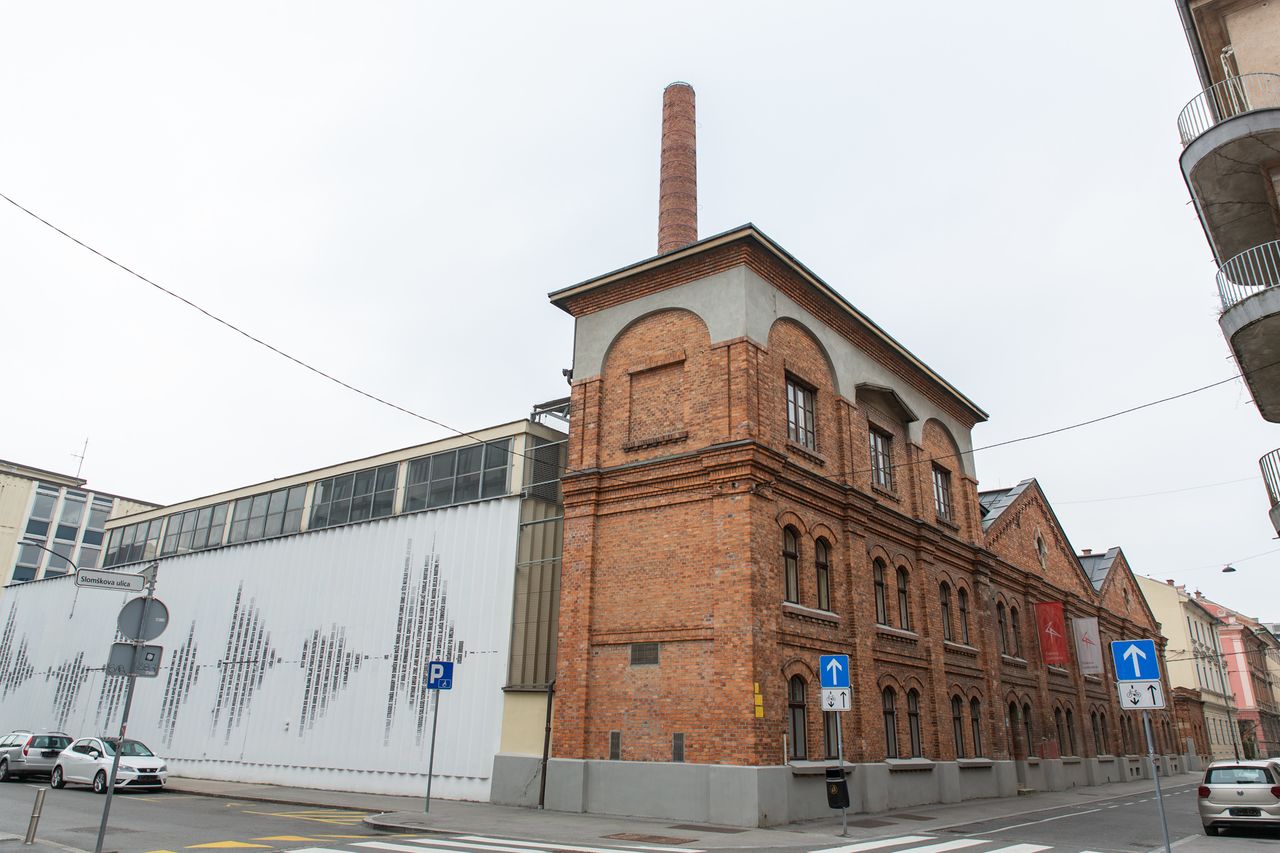 The Old Power Station is one of the most important contemporary performing arts venues in Ljubljana.
The Old Power Station is one of the most important contemporary performing arts venues in Ljubljana.
A great example of finding a solution in time for both the preservation of a well-maintained industrial architecture and a lack of rehearsal space for performative arts is the Stara Elektrarna - Old Power Station, the most beautiful cultural venue in Ljubljana, managed by Bunker Institute. This technical monument represents a fruitful collaboration of actors in the field of economy, heritage, cultural policy and independent performative sector, that gave birth to an art-space, hosting a variety of shows, conferences, dance and theatre performances, and other interdisciplinary events in every corner of the building and its surroundings. Lately also reaching out to the exterior of the façade, as a form of intervention in frames of Mladi levi Festival, although Bunker for quite a while enriches the entire neighbourhood with collaborative projects, enabling the ground for new actors as well.
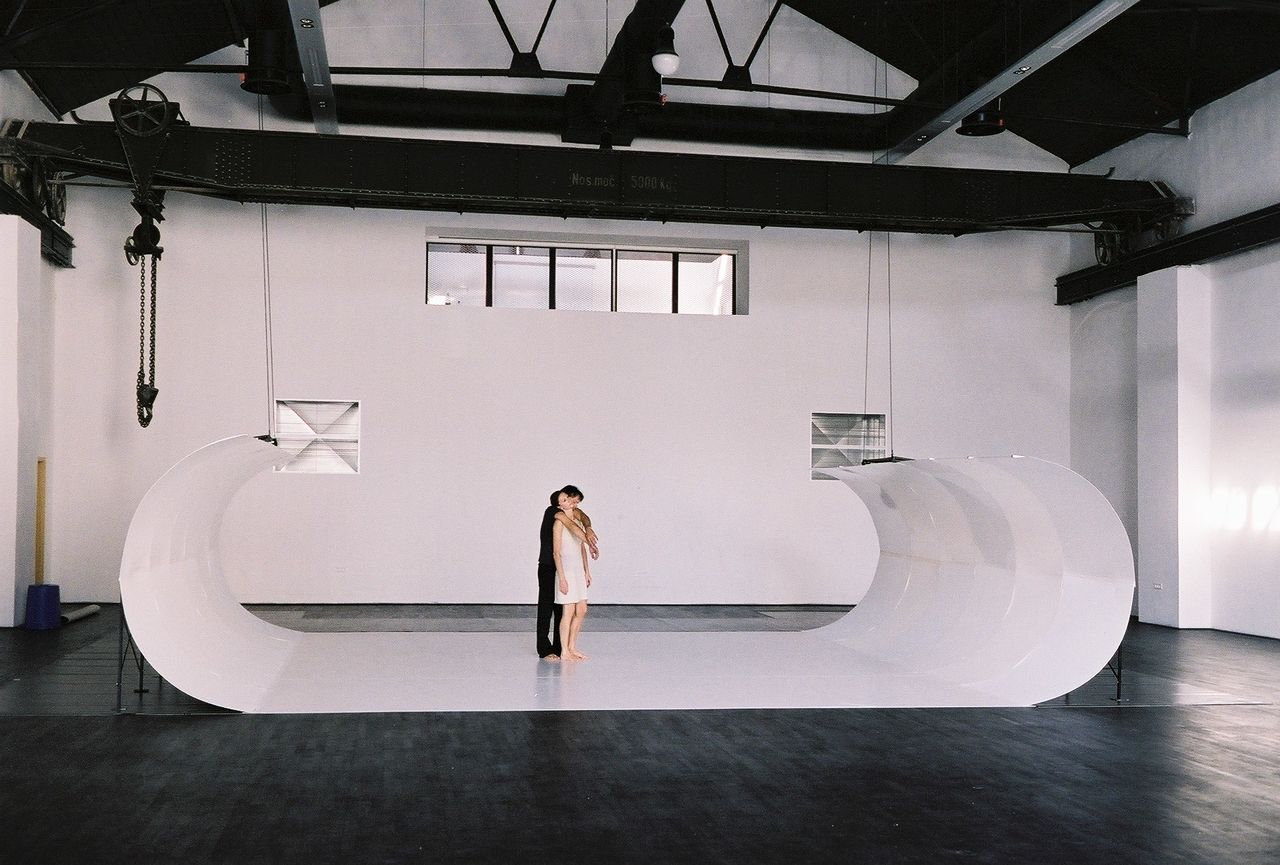 Dance performance A Quick Story by Sanja Nešković Peršin and Branko Potočan, Bunker Institute production performed at Stara Elektrarna - Old Power Station, 2004.
Dance performance A Quick Story by Sanja Nešković Peršin and Branko Potočan, Bunker Institute production performed at Stara Elektrarna - Old Power Station, 2004.
Next followed Tobačna 001 Cultural Centre in 2011, the thoroughly renovated Plečnik House which re-opened in 2015, and Švicarija Art Centre, opening its doors as a gallery and art residency centre in 2017. The city also holds a strong vision of transforming several spots of the city into a new cultural district: to connect the museum quarter (the Slovene Ethnographic Museum, the Museum of Contemporary Art Metelkova (MSUM) and the National Museum of Slovenia - Metelkova) and the Metelkova mesto Autonomous Cultural Zone with the planned Rog Centre, all the way to the new Cukrarna Palace.
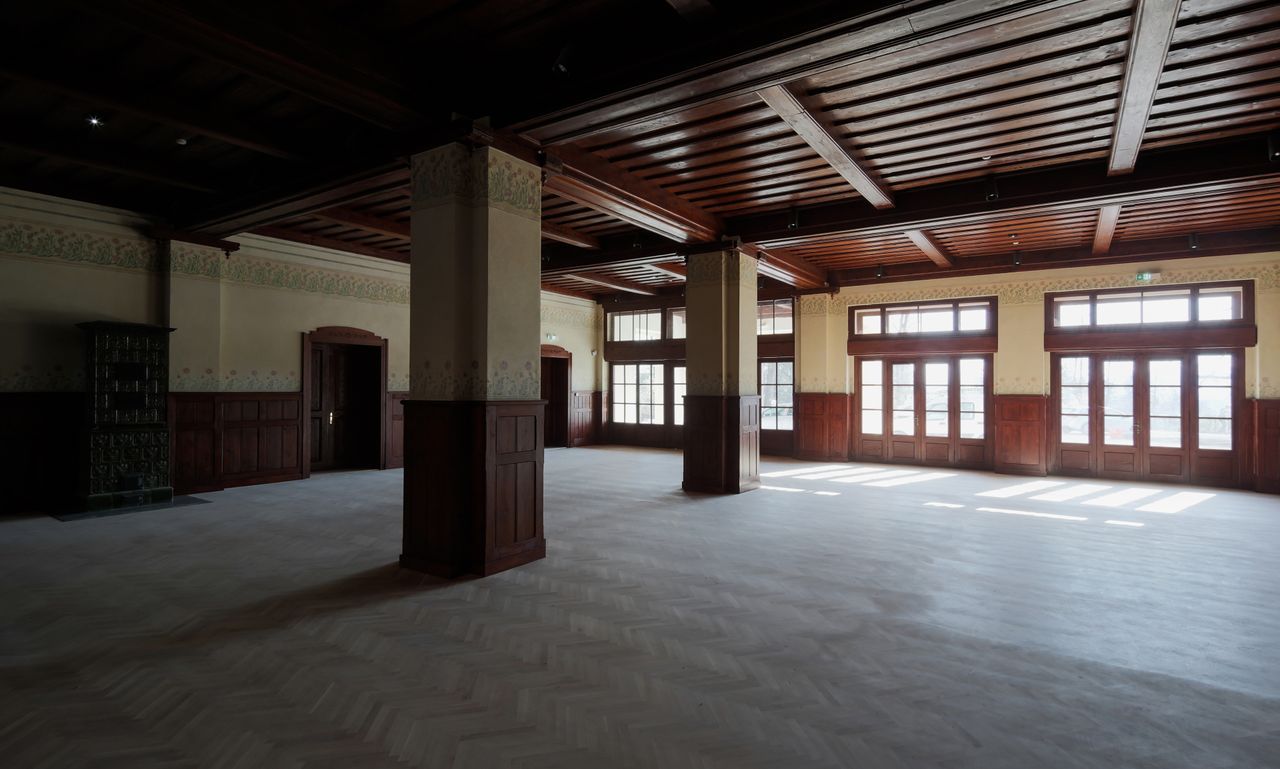
Managed by the Museum and Galleries of Ljubljana, RogLab is a 3D public workshop, a production laboratory and (still) a pilot project for the future Rog Centre. The architectural project of a new cultural centre was selected in 2008 with a public call, granting first prize to the proposal of MX_SI, a Slovene-Mexican architectural office, based in Barcelona.
In the last decade, the perspective and management model, along with the building plan, changed. In the meantime, an autonomous creative space was established in the former factory Rog, giving ateliers, studios and community spaces to a colourful range of people, projects and organisations, to mention only R.O.G. Skatepark. All of them are now in need for new premises, because in 2021, renovation kicked-in, raising the voices of intellectuals, private institutions and NGOs in support.
Cukrarna is the oldest preserved object of industrial, cultural heritage in Ljubljana. Although initially built as a sugar refinery in the 19th century, it ceased this operation after some decades. Throughout an entire century, it went through different phases and temporary uses: mostly as public housing and widely known as a shelter for impoverished young poets from the time of Slovenian modernism. At the end of the 20th century, in very poor condition, it was instated as a monument in the Register of Slovene Cultural Heritage and closed. Then the Municipality of Ljubljana decided upon its new use – a multi-purpose cultural venue with a modern, vast gallery space. The architectural competition by the Chamber of Architecture and Spatial Planning of Slovenia (ZAPS) resulted in a winning proposal by architectural studio Scapelab.
As the renovation of Gallery Cukrarna is to be finished in autumn 2021 – and with the 25th anniversary of the World of Art: School for Contemporary Arts – a new partnership has been established to offer the premises to the school as a dislocated unit of the SCCA-Ljubljana Centre for Contemporary Arts, thus connecting educational process and cultural production.
Just before the reconstruction began in 2018 (with the financial support of the Slovenian Government and European Regional Development Fund), a few temporary exhibitions and events were presented in one part of the building, including the Lighting Guerrilla Festival, the Sonica International Festival of Transitory Art and the annual exhibition of the A.V.A. Institute, Academy of Visual Arts.
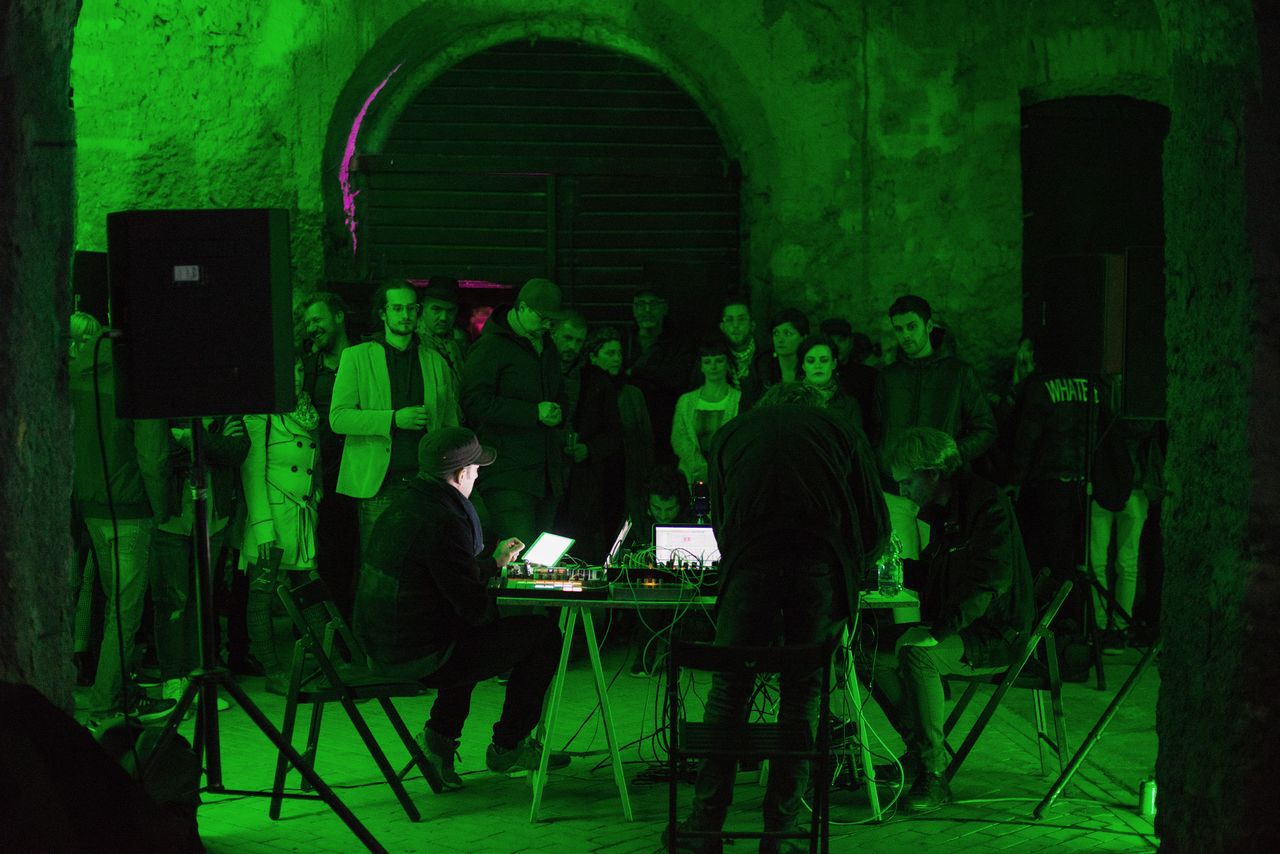 Group exhibition opening at Cukrarna Palace, Sonica International Festival of Transitory Art, 2017.
Group exhibition opening at Cukrarna Palace, Sonica International Festival of Transitory Art, 2017.
Post-industrial towns and their legacies
Koroška
Besides the historic Carinthian plebiscite at the beginning of the 20th century, dividing part of the region to Austria, Koroška or Carinthia is well known for its industry. In the last decades, the region’s natural beauty with its hiking and biking trails has become its flagship. Koroška encompasses three valleys, named by the rivers that pass through them: Meža, Mislinja and Drava. Meža is the most industrialised – with Ravne na Koroškem, known for its steel industry, and the mining towns of Črna na Koroškem and Mežica.
The beginnings of the Ironworks in Ravne na Koroškem go back to the year 1620. In the 19th century, a steel mill was established, setting the base for the development of machine production. Even before World War I, the quality steel they produced was sold to the Middle and Far East and to Russia. Employing around 6,000 workers, this pride of ex-Yugoslavia went into reorganisation in 1991 after Slovenia declared independence. From a single iron and steel manufacturing company Železarna Ravne, several specialised production and service facilities were created in 1992. In 1994, the oldest preserved buildings of Ironworks Ravne were declared cultural monuments.
Štauharija, a manufacturing plant that preserved its original form, represents the technical heritage of Ironworks with a tradition of 400 years. It is now part of the Ravne na Koroškem Museum that operates under the auspices of the Koroška Regional Museum, with a permanent exhibition of iron and steel industry. The space hosts different events, workshops and lectures. Even the traditional edition of the Jazz Festival, organised by Jazz Ravne took place there in 2019.
Further north along the Meža Valley, a lead smelter operated for many decades at the Mežica Lead and Zinc Mine until its closure in 1994. Simultaneously, the idea for a new, tourist use for the tunnels was evolving in an attempt to interconnect the technical heritage with culture. A few years later, a visit to the selected part of the so-called tourist tunnels was accessible by a cave train. In 2002, underground cycling was made available; nowadays, you can also explore selected underground tunnels with kayaks.
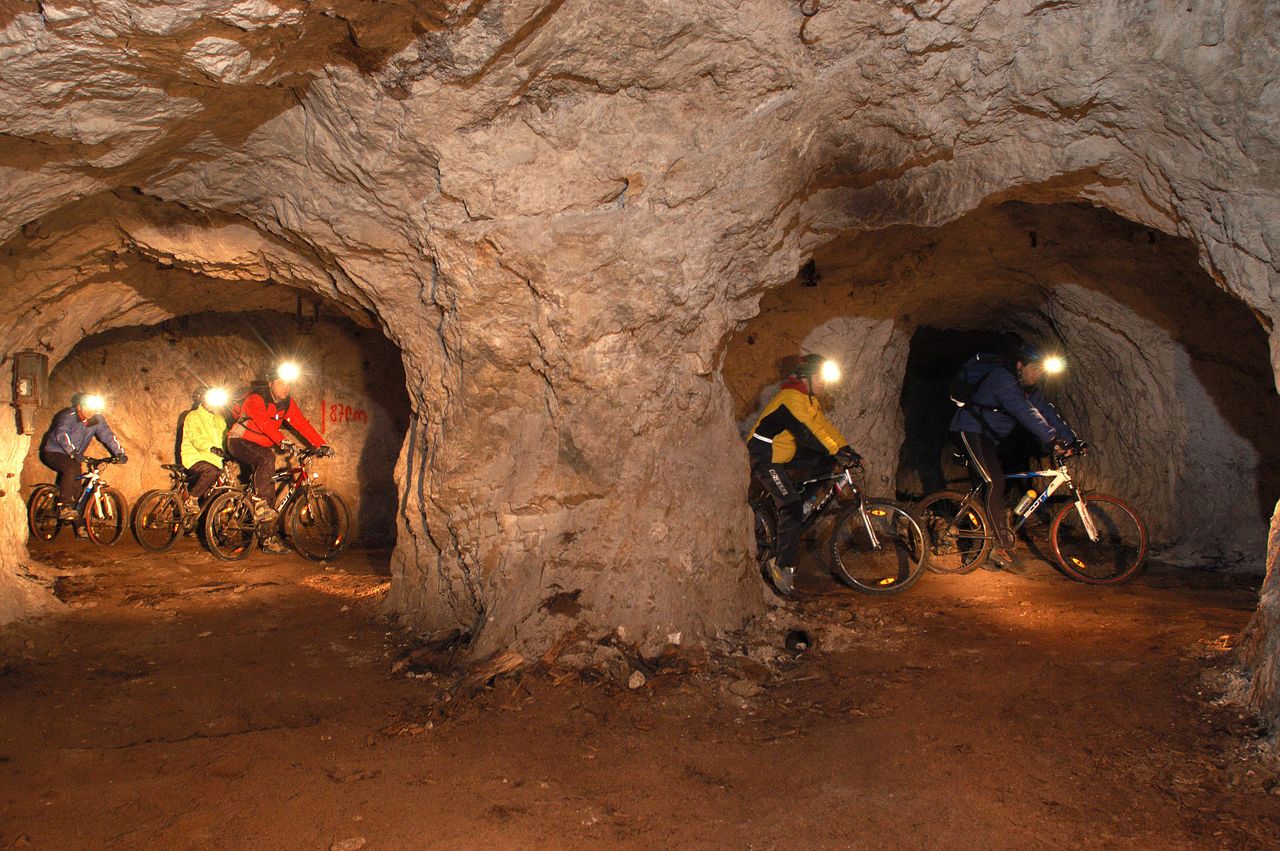
The Podzemlje Pece, Tourist Mine and Museum offers a pleasant mixture of activities: part educational, learning about the work in the mine; part recreational, indulging in subterranean cycling and kayaking; and part cultural, attending special concerts in the authentically preserved section of the ore deposit, in which miners used to gather as they came to work. Some of the concerts in the mine have been performed by Orlek, Katalena, The Stroj.
Adding cultural content surely brings life and economic value to the disused sites. Still, the real challenge remains: finding a sustainable solution for environmental pollution, a side-legacy of centuries-long lead and zinc ore exploitation, so enjoying those sites and the surrounding nature can be uncontaminated, and the land can gradually fully recover.
Zasavje region
While the Zasavje region has been shaped industrially and economically alongside the mines and its identity still mainly reflects that times, the post-industrial town of Trbovlje is transforming itself into a new media art venue. In 2009, it introduced the Speculum Artium Festival under the umbrella of the initiative Trbovlje, New Media Setting.
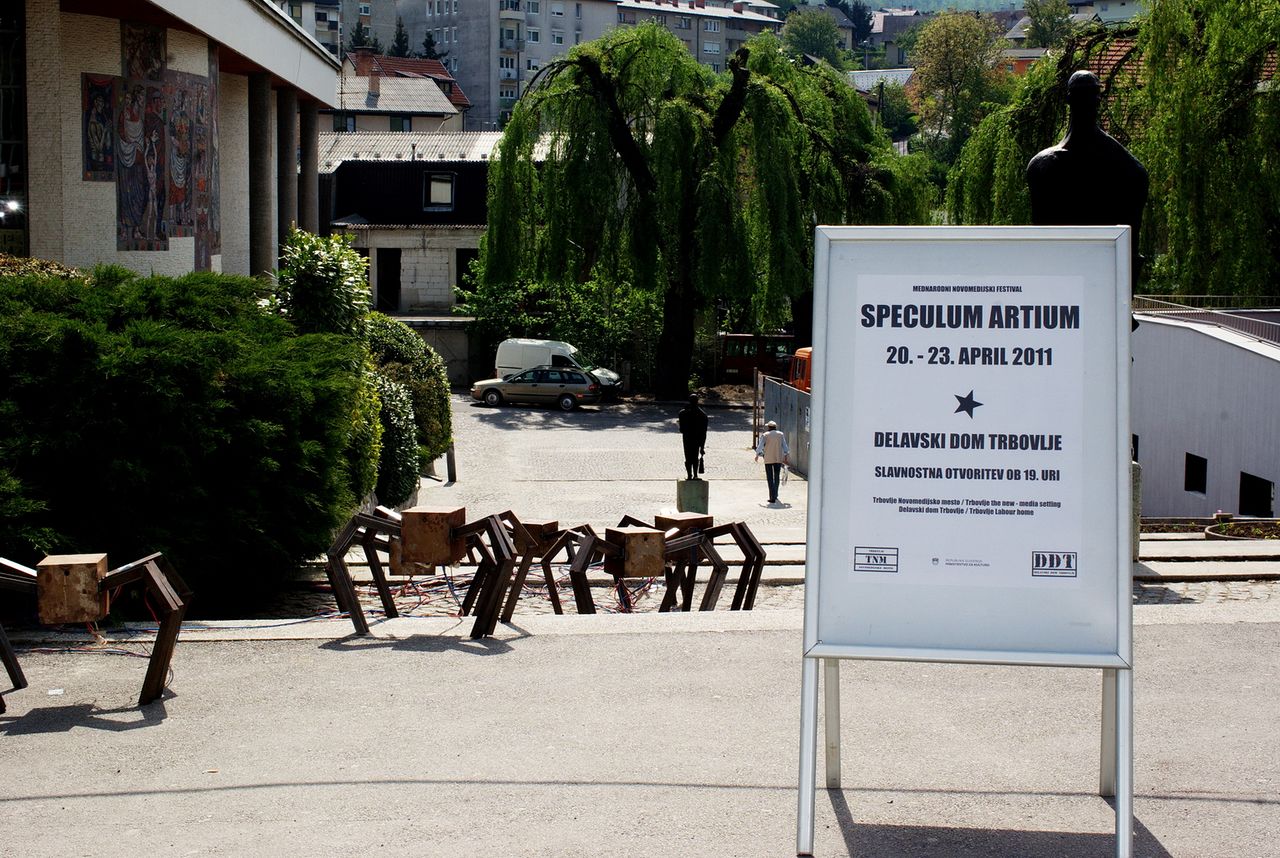 Posters announcing the Speculum Artium Festival in Trbovlje, 2011.
Posters announcing the Speculum Artium Festival in Trbovlje, 2011.
With a vision to develop a new cross-border cultural-tourist route and present it at the newly established Festival of Industrial Heritage in the framework of the Rijeka – European Capital of Culture 2020, a Slovenian-Croatian partnership was established for the project INSPIRATION "Industrial heritage of Trbovlje, Slovenska Bistrica, Labin and Rijeka through the development of cultural tourism". Launched in 2016 by the Municipality of Trbovlje, the project was co-funded by Interreg EU in 2018. The main goal of the project was to encourage the revitalisation of former industrial towns and their heritage by creating a series of innovative cultural events and tourist products, taking visitors from the sawmills and mills of Pohorje, via the mines in Trbovlje and Labin, HR, all the way to the port of Rijeka.
Since the closure of the mine, the virtual (and actual) mining museum 4th Dritl presents a story about the Trbovlje coal mine and the lives of people working in it and/or living in the area. By using new media technology with a guided tour through an authentic reconstruction, featuring original items, the organisers are trying to keep alive the history of the mine, its tales and legends. The concept of combining virtual and actual presentation enables wider accessibility, while an in-depth version of a tour leads to the actual formal mining areas, addressing environmental issues as well and outlining the possible future use with restoring and repurposing the land through new use.
The project is run by the regional Delavski dom Trbovlje Cultural Centre, a venue with a diverse art programme, introducing music, film, theatre, new media, and also home to several cultural and educational institutions.
Zasavje is the birthplace of some of the most prominent groups and artists, Laibach and choreographer and dancer Iztok Kovač of EnKnapGroup (EKG) among them. The astonishing scene of Kovač on the 360-metre chimney of the Trbovlje Power Station was the first of its kind, as the award-winning dance film Vertigo Bird was presented in 1997. Directed by Sašo Podgoršek and produced by En-Knap Productions, the film was just the peak of an entire dance performance in the coalmine of Trbovlje. The team went on to create the films What Are You Going to Do When You Get Out of Here? (2006) and Vashava (2014).
 Still from the film Vertigo Bird by En-Knap Productions, with Iztok Kovač atop the chimney and Aleš Hadalin in the foreground.
Still from the film Vertigo Bird by En-Knap Productions, with Iztok Kovač atop the chimney and Aleš Hadalin in the foreground.
The highest chimney in Europe has recently undergone another challenge by two young and world-renowned Slovenian climbers Janja Garnbret and Domen Škofic, winners of multiple lead climbing and bouldering awards. The longest artificial route in the world took two years of design, planning and preparation, and was mounted only for this occasion, which attracted attention worldwide.
Idrija, Velenje, Maribor
Other post-industrial town and cities also offer a variety of sight and events, mostly joining art, culture and tourism into a new experience, with a starting point in preserving the heritage and presenting their specific history. Idrija, with the former world's second-largest mercury mine and a UNESCO World Heritage Site.
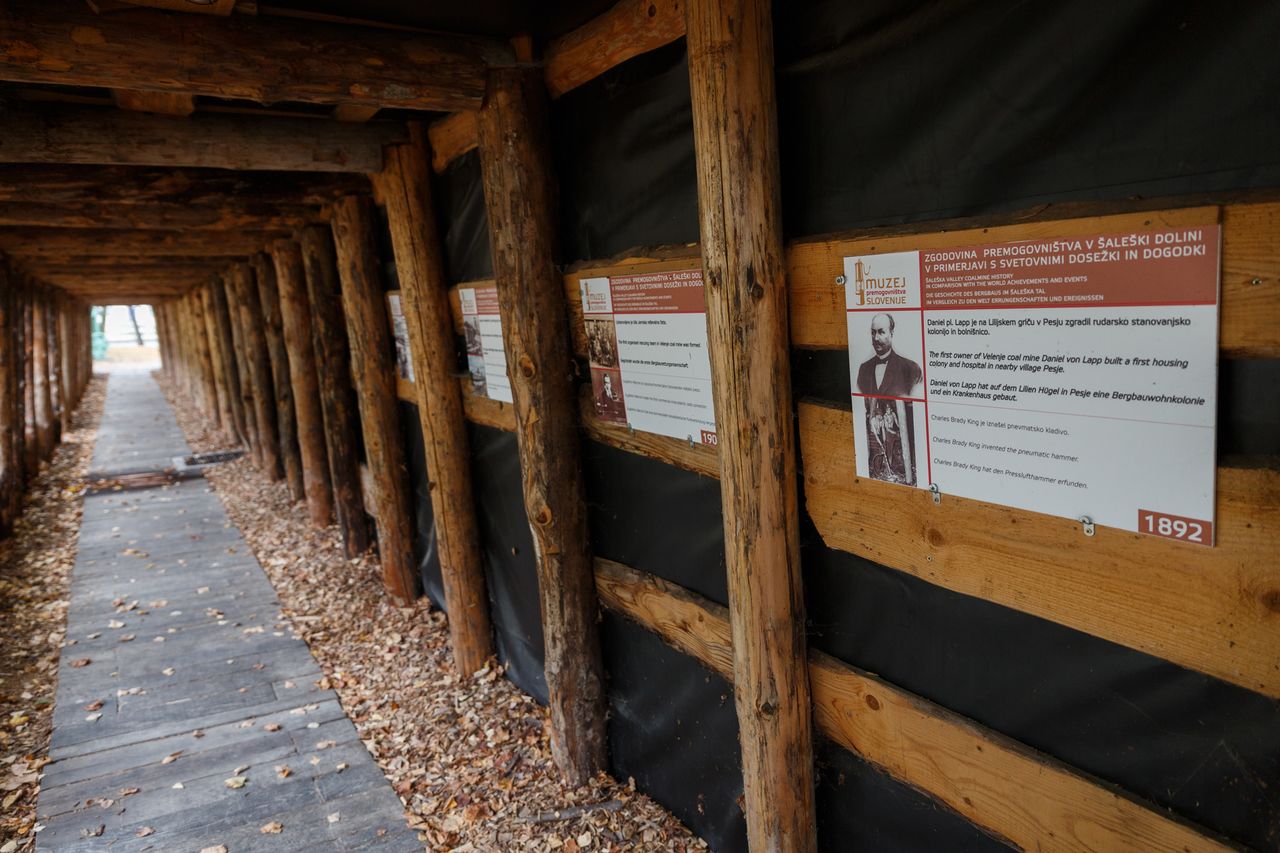 The presentation of wooden supports in mines and the history of coal mining in Šaleška valley, 2019.
The presentation of wooden supports in mines and the history of coal mining in Šaleška valley, 2019.
Velenje, with the Coal Mining Museum of Slovenia and in 2020 rounding the EU project BRIGHT FUTURE, led by the Scientific Research Centre (ZRC SAZU), Slovene Academy of Science and Arts, with the main objective to invent place-specific urban strategies for industrial towns in Europe, taking into account local narratives and strengthening its resilience.
On the other hand, ongoing production can still be found in the former factory TAM in Maribor, nowadays called Tezno Zone, applying innovative concepts in the area. To name only a few.
Smaller and (con)temporary interventions
Several young interdisciplinary groups, among them, ProstoRož and Štajn Architects, are responding to the tipping points in the local environment with participatory processes, addressing the public and decision-makers, many times outlining possible solutions with small and temporary interventions in-situ. Municipalities play a big role in making changes through their long-term strategies and investments. Highlighting the important spaces, places and rituals is often the first step in gaining recognition of the historical, architectural or ethnographic value and to protect these spaces that have shaped and moulded our shared cultural identity.
Author bio
With a background in architecture and many years experience as a cultural producer and organiser for high-visible architecture and design projects, events and festivals, Tea Pristolič has been covering the field of architecture and design for Culture.si since its beginnings.

